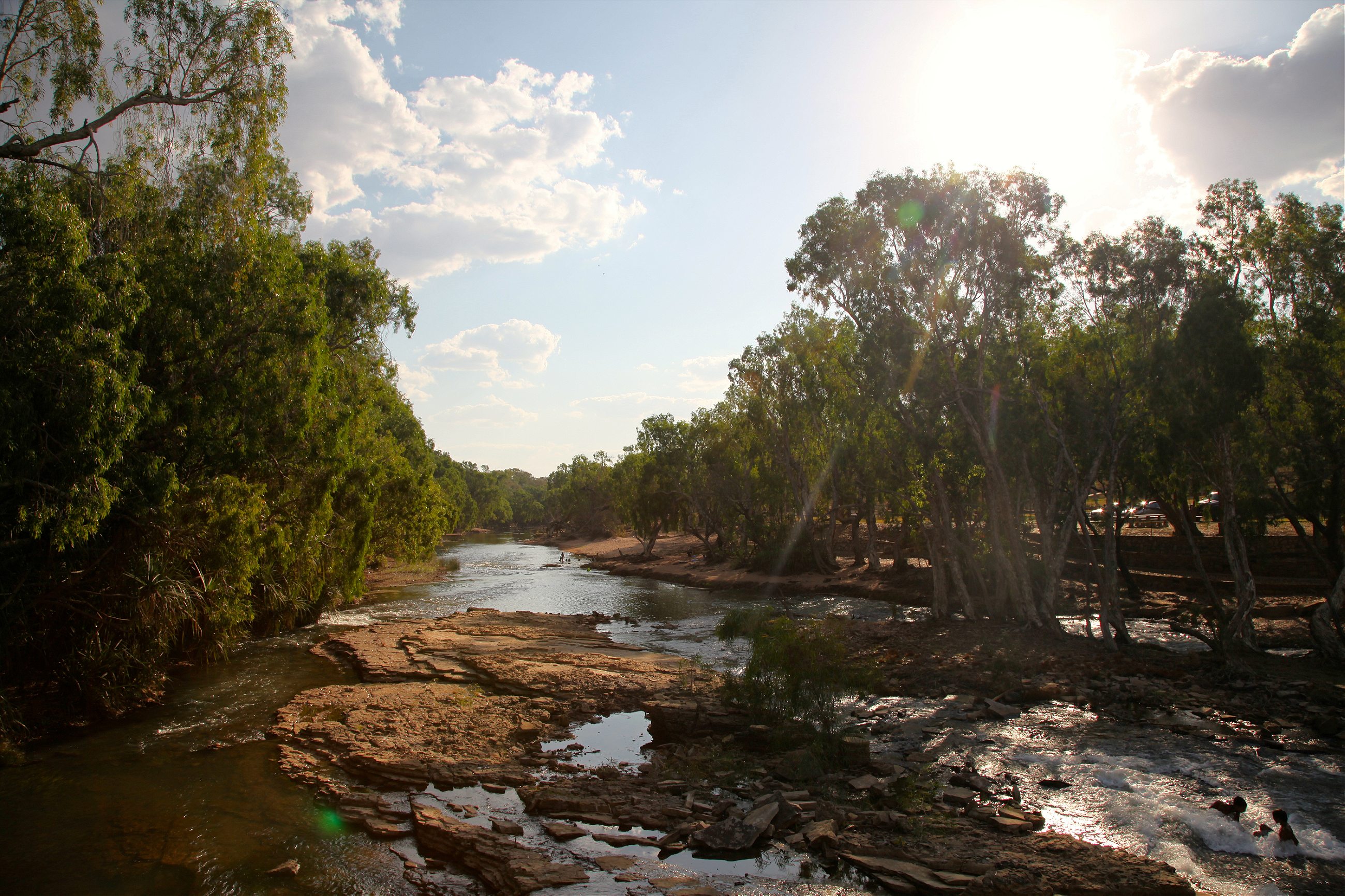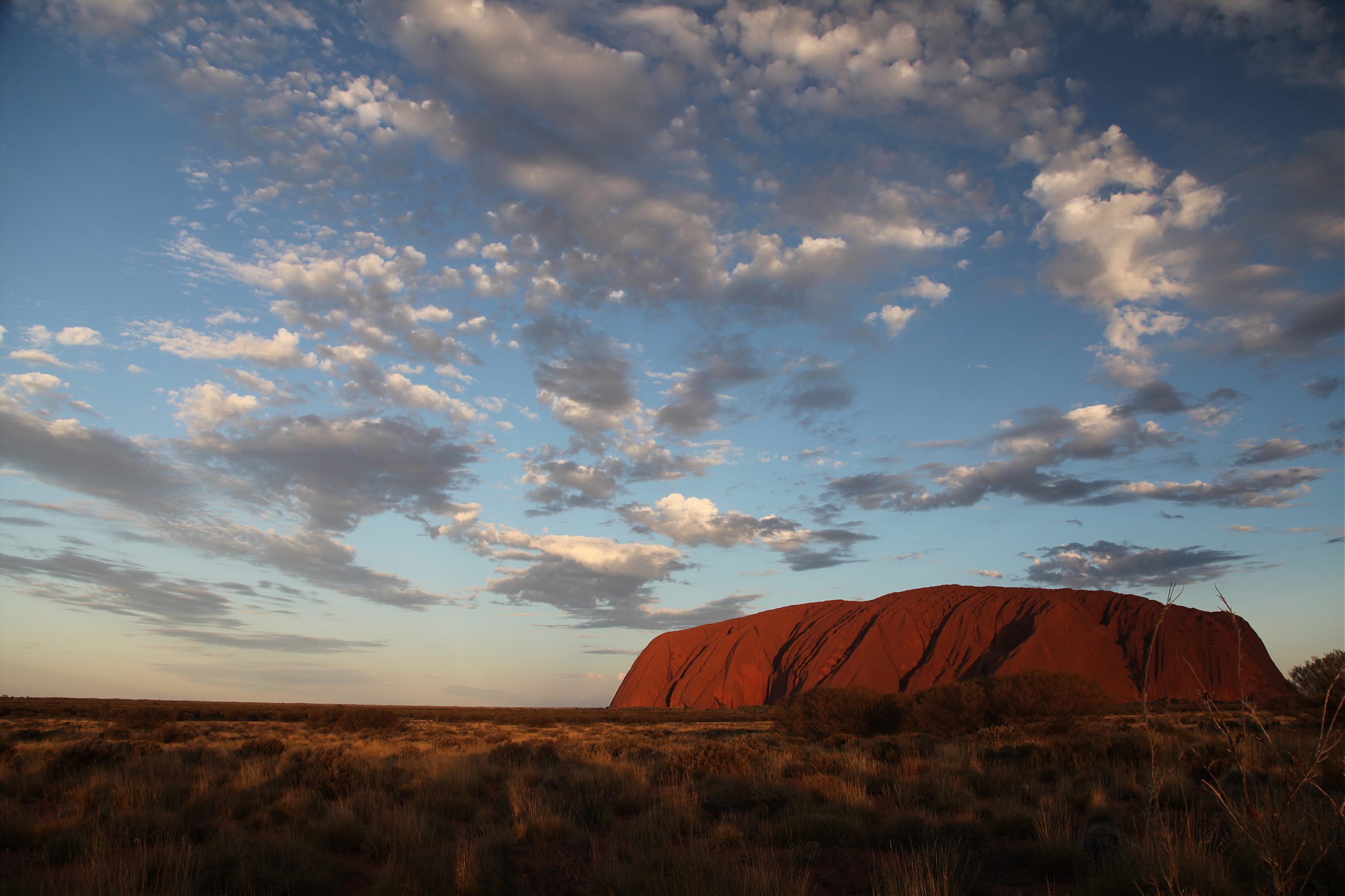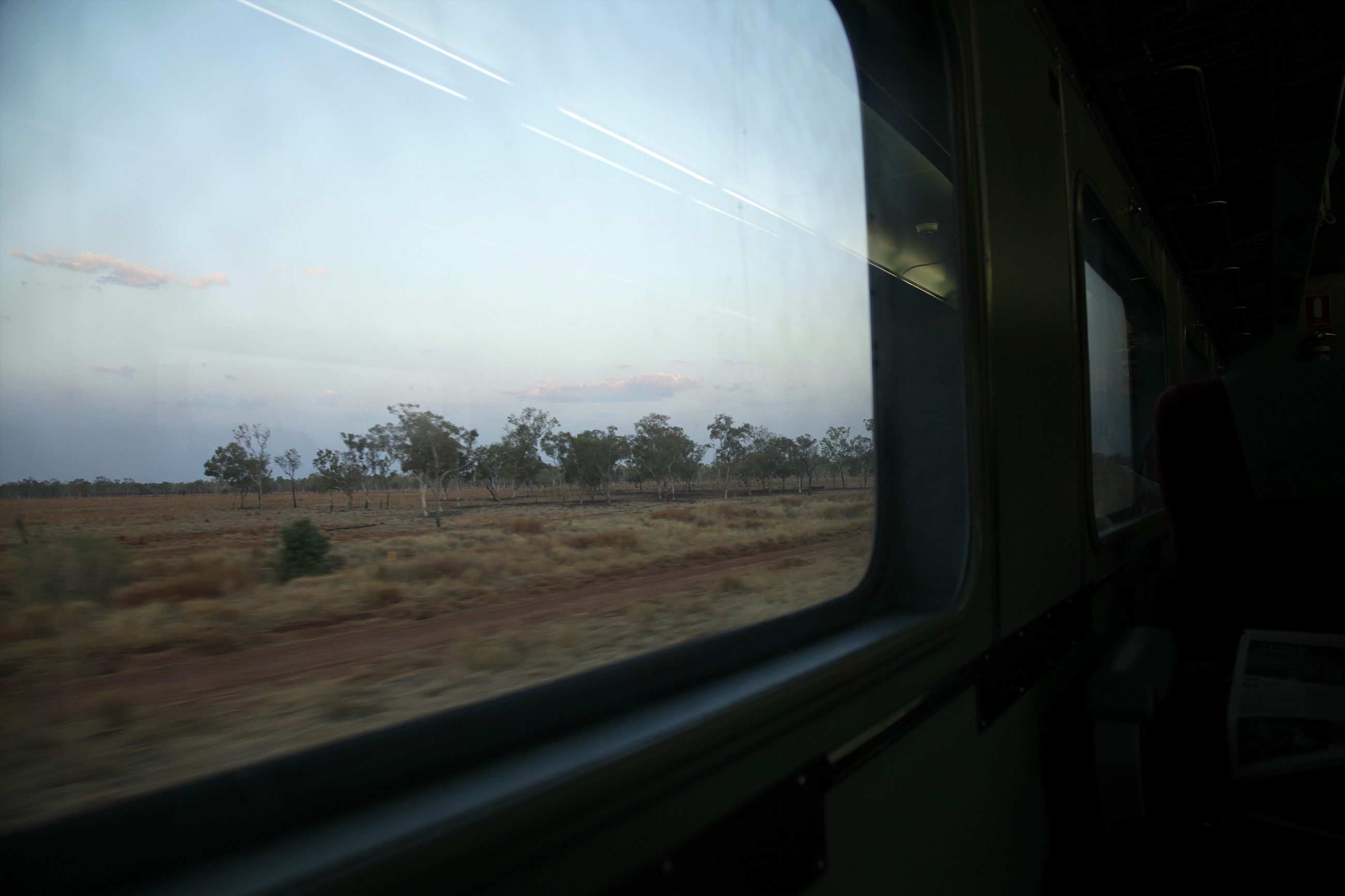The Ghan—a three-day, 1,850-mile train journey—is the best way to experience the vastness of the Australian outback.
I’ve been fixated on the moon for the last two hours, anticipating the lunar eclipse scheduled to take place tonight. My nose is pressed to the window and I’m staring out into the darkness, the lonely outback lit up by nothing more than the bright orb in the sky and the dim staccato light cast from the train windows to the ground. As I look out to a vast, mysterious land, still almost entirely untouched by humans, the moon’s light begins to fade.
When I boarded the train earlier this morning, I had no idea there would soon be a total lunar eclipse. But as we finished the dinner we’d packed ourselves—avocados smeared onto slices of bread—a scratchy voice on the loudspeaker informed me I’d serendipitously booked an overnight train trip on the same day as this unique celestial occurrence. In a total lunar eclipse, while the earth completely blocks the moon from sunlight, it doesn’t go completely dark. Some light filters through the earth’s atmosphere and indirectly lights up the moon’s surface, giving the moon a red hue. A Blood Moon. As red as the ground outside the train.
It’s my first trip to the country and my Australian boyfriend, who hails from Alice Springs, a small town that is the outback’s thriving heart, far away from cosmopolitan luxuries and deep in the middle of the desert, wants to ensure that I see the real Australia. Not just Melbourne and Sydney, but the parts of Australia that have shaped the country’s identity.
In Australia’s vastness, there is also great loneliness. The continent is slightly smaller than the continental United States (2.9 million square miles compared to 3.7 million square miles), but the difference in population is huge—23 million and 316 million, respectively. Australia’s population density is just 7.5 people per square mile. To fully grasp this loneliness, you must venture beyond the cities. You must travel into the wilderness. The bush. The outback.

My boyfriend and I decided that covering the 1,850 miles between Darwin and Adelaide would be too rough by car; stretches of road with little more than a roadhouse every couple of hundred miles serving up pies and sausage rolls. But if we took the train we could relax, avoid the potential calamity of accidentally hitting a kangaroo at dusk, and still manage to experience the heart of Australia.
We decided we would ride The Ghan, a transcontinental railway that cuts through the middle of the outback. The trip takes three days and two nights. It’s named after the cameleers—or camel drivers—who helped make Australia’s interior accessible to both trade and permanent residents. The cameleers came from what is now Pakistan and surrounding areas, but were all grouped into one all-encompassing “Afghan” category—“Ghans” for short.

The outback was never easily accessible, and still today, if you want to travel to the heart of Australia most people arrive by airplane, seeing the desert landscape from the air. Because of the distance—individual ranches and outback stations can cover thousands of square miles— trips within the outback often take place in small bush planes. For the individual traveler, however, that kind of access can be difficult. A ride on The Ghan is a chance to pass through an area of country few people see up close, while stopping at several towns along the way.
The Ghan leaves once a week, either traveling north to south or vice versa. Often travelers disembark halfway to explore Alice Springs, which is the jumping off point for visiting sites like Uluru, the large sandstone formation that is a UNESCO World Heritage Site, and nearby Kings Canyon, formed over millions of years and part of Watarrka National Park. With its once a week schedule, you don’t plan your Ghan trip around the rest of your itinerary, you plan your itinerary around the Ghan.

The first Ghan train left the Adelaide station headed to Alice Springs (which was called Stuart at the time) in April 1929, the tracks following the route of John MacDouall Stuart, a Scottish explorer who led the first successful expedition traversing Australia from south to north. While the outback can be an unforgiving place, MacDouall Stuart never lost a man on any of his expeditions.
While our carriage houses a variety of passengers, it isn’t full. Most Ghan travelers are well-off retirees, on their “journey of a lifetime,” traveling in luxurious sleeper cars, their meals served on white tablecloths. We are in a lower-class car—the Red Service—where seats recline but there are no beds. There’s a dining car called the Matilda Café, which serves classic Australian pasties, vegetarian options, and a hearty breakfast of eggs and sausages that would make an outback rancher happy. Platinum and Gold Service guests are treated to more elaborate regional and seasonal fare.
On my first night on the train, I order an early evening drink in the Matilda Café—a pre-mixed can of gin and tonic. I ask for a cup so I didn’t have to drink it like a soda. We nurse our cocktails while other passengers in the Matilda Café wait for their dinners, everyone captivated by the view out the car windows as the sun began to set.

The Ghan is anything but fast. With an average speed of about 53 miles per hour, this is the definition of slow travel, but the train’s snail’s pace is perfect for taking in the desolate, unforgettable landscape outside the window: dusty red ground and dry desert foliage well adapted to the arid environment. We pass a pile of old timber, what looks to be a former cattle loading area. The pieces of wood are dark with age, left to bake under the Australian sun.
While other railways in the country pass through stretches of wilderness, there are always signs of modern life—a telephone pole, a small road. In the outback, there is nothing. From my window view, there’s only land, as far as I can see.
Walking the four miles into Katherine is discouraged.
The first afternoon of our trip, we stop at Katherine. The fourth largest settlement in the Northern Territory, it’s known to tourists for its gorges and waterfalls. To allow passengers the chance to experience all the places where the train stops, The Ghan offers a selection of tours in both Katherine and Alice Springs. A helicopter tour of Katherine Gorge and the surrounding area sounds tempting, but at $380 AUD—$295—per person, it’s out of the question.
We decide to walk the four miles into Katherine, which is discouraged by the train staff because it’s the middle of the day when the sun at its most intense. October happens to be the hottest month of the year in Katherine, with an average temperature of 100° Fahrenheit. But the budget traveler in me refuses to pay $20 AUD—about $15—for a shuttle ride into town, no matter how slowly the heat forces me to walk, or how much water I have to guzzle.

Huge trucks fly by us as we hug the edge of the Victoria Highway, which was evidently not built for pedestrians. I have to pause every 15 minutes, often lamenting leaving the air-conditioned comfort of the train. A farm stretches out to our left; a rusty hand roll irrigation system extends out over the parched field. I wish that I had a respectable Australian outback hat.
Eventually we come to Katherine Hot Springs, situated on the Katherine River, with plenty of swimming holes to cool off. I’ve brought my swimsuit, but don’t care enough to put it on. I sit down in the river in my shorts. They can dry off on my way back to the train.
Back on the train, enjoying the evening, I wait for the promised lunar eclipse, doing nothing more than staring out the window. I watch the sky as the earth’s shadow slowly overtakes the moon.

The lights in the carriage were turned off long ago. A few passengers have switched on reading lamps, but otherwise the interior is dark. The sun sets quickly, as it does this close to the equator, splashing purples and pinks across the red rock landscape.
The next day we arrive in Alice Springs, where my boyfriend and I will spend a week exploring before re-boarding the Ghan to complete the second leg of the journey. We rent a car to drive the almost 290 miles it takes to get to Australia’s famed Uluru—the red rock.
The color of the rock changes with the time of day, the angle of sunlight altering Uluru’s hues. Whatever the color, Uluru is a powerful sight. At sunset we watch it change from rosy pink to dark red; at sunrise we see it change right back, framed by the blue sky behind it.
In a few days time we’ll board the Ghan to Adelaide, traversing more of the Big Red Center, rendered no less spectacular when viewed from behind a train window.